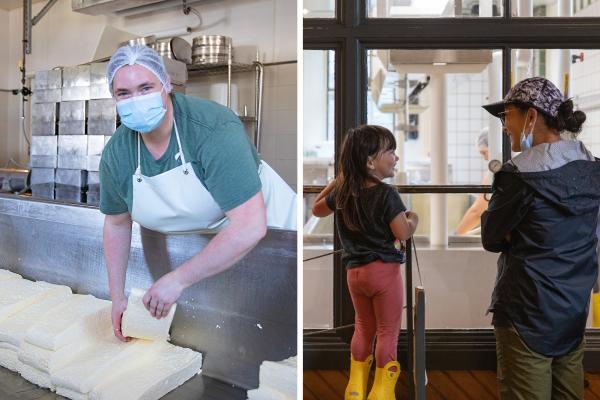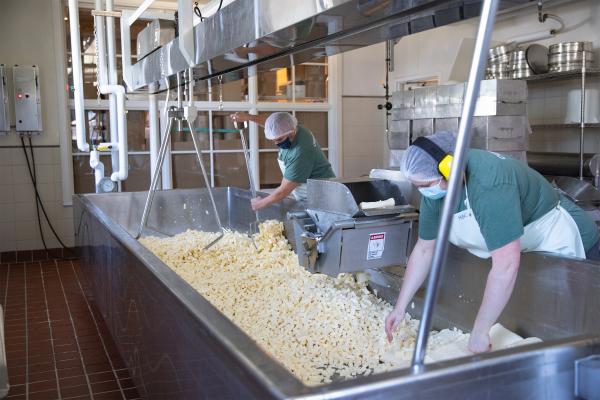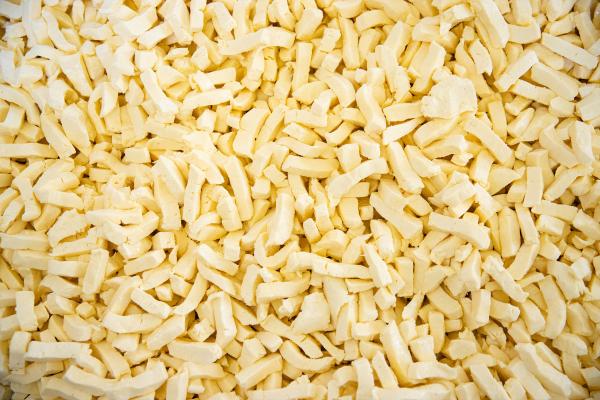Five Frequently Asked Questions at Meet a Cheesemaker
Since late June, we’ve been answering questions about cheesemaking at our almost daily “Meet a Cheesemaker” chats in the Farm Barn. Here are some of the questions we get asked most often, and our answers! Come join us sometime and ask us your question.
What changes milk into cheese?
The short answer is: rennet! Rennet is a coagulating enzyme that we add to cultured milk. It makes the proteins (caseins) start to stick together in a pudding-like gel (the curd) and separate from all of the liquid (whey). We cut the big piece of curd into little pieces with our cheese harps - basically steel frames strung with wire that we pull through the vat - and stir them before letting them settle to the bottom of the vat and draining off the whey.
What do you do with the whey?
The whey is drained through an underground pipe into a big storage tank buried in front of the Farm Barn. The dairy team comes by every week or so to pump the whey into a truck (the “Honey Wagon”) and they spread it on our fields as fertilizer. That fertilizer feeds our pastures and hay fields, which in turn feed our herd of Brown Swiss cows, and eventually cycles right back into the vat as fresh milk!
How do you make a sharp cheddar cheese?
Here’s an insider secret: “sharp” doesn’t actually mean one specific flavor. It’s a word that cheddar makers can use to describe the “flavor profile” of their different cheddars. Generally speaking, younger cheddars (like our Six Month) have milder flavors and creamier textures. Over time, the cultures living in the cheese break down the big milk proteins and fats into smaller and smaller pieces that our taste buds can detect, so the cheese will develop more complex flavors. Italso starts to get a little bit more crumbly as it ages. We consider our typical Six Month a “medium” cheddar, One Year a “sharp” cheddar, and Two Year an “extra sharp” cheddar. The Three Year “reserve” cheddar has even more time to develop flavor and complexity, and will often start to form tyrosine crystals that add a tiny crunch to the texture.
What makes it cheddar cheese versus other cheeses?
At any point during the cheesemaking process, changing the ingredients or the way we work with the milk and curds will change the final cheese. For example, we could add cultures to the milk that produce gas when they ripen. This would produce a swiss-style cheese with holes; we could ladle the uncut curd directly into small molds to make soft brie-type cheeses; or we could cut the curds into smaller pieces and heat them up more to make a harder parmesan-style cheese.
The step in the cheesemaking process that is unique to cheddar-type cheeses is called... cheddaring! After the whey is drained, we let the curds knit back together into a big pack, cut those packs into slabs, then stack the slabs on top of each other to press more whey out and help the curds stick together again. After cheddaring, we mill the slabs back into finger-sized curds (like the ones you eat on poutine or buy as “cheese curds”), and add salt. Then we scoop the curds into big steel boxes (“hoops”) and press the hoops overnight until the curds all hold together as big blocks of cheese.
The result is a layered texture (from repeatedly cutting and reforming the cheese), a firmer curd (we squeeze out so much whey), and salt that is evenly spread throughout each block (in most other cheese styles, salt is added to the outside of a smaller, already-formed wheel). All of these characteristics make the perfect environment for the cultures in our cheese to ripen and produce those distinctive cheddar flavors over time.
Why don’t you sell cheese curds?
We use raw milk to make our cheddar because the cultures growing in our milk produce complex, delicious flavors that directly reflect the pastures that our herd graze on. To ensure that only healthy cultures survive in the cheese, all raw milk cheeses sold in the US must be aged for a minimum of 60 days. Unfortunately, fresh, loose curds would definitely lose their “squeak” during that time — and they don’t age well either!
Want to taste or share some of our delicious cheddar? Order online, or, if you live locally, order at our Farm Store for pickup.



